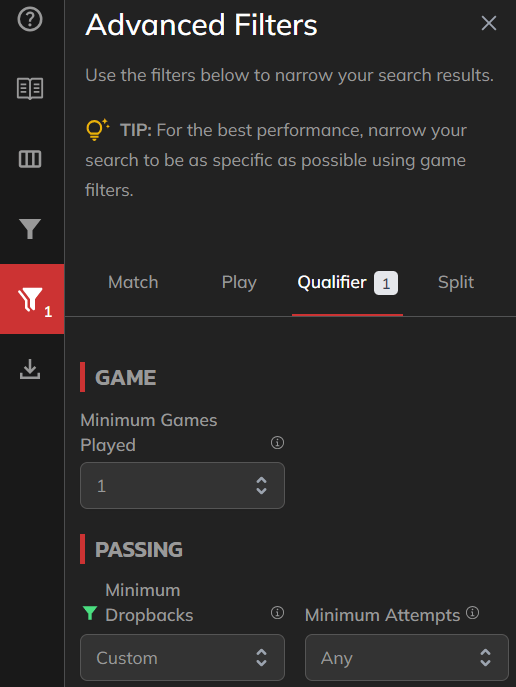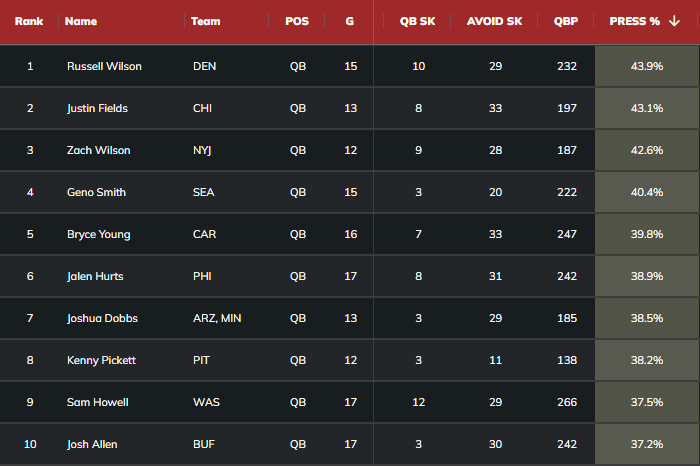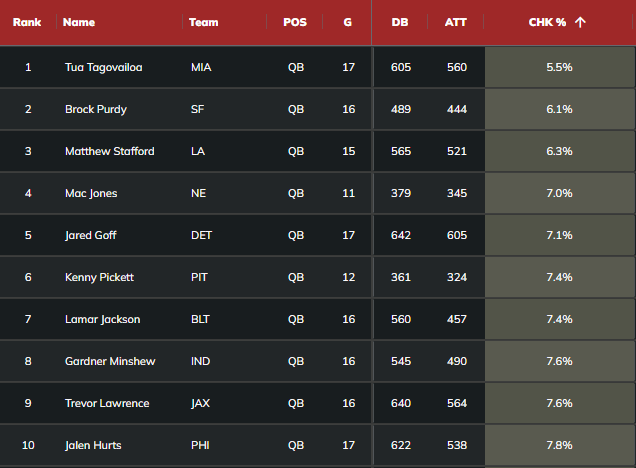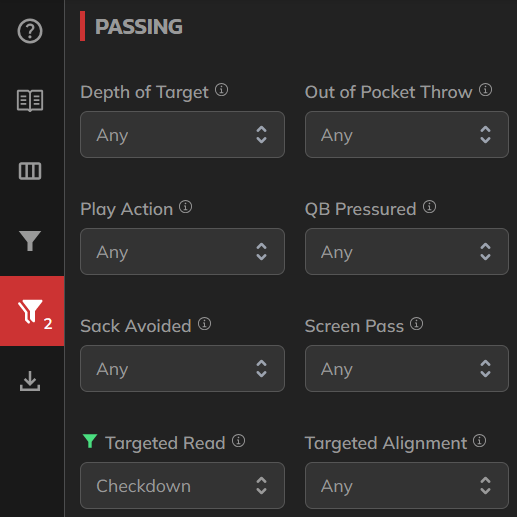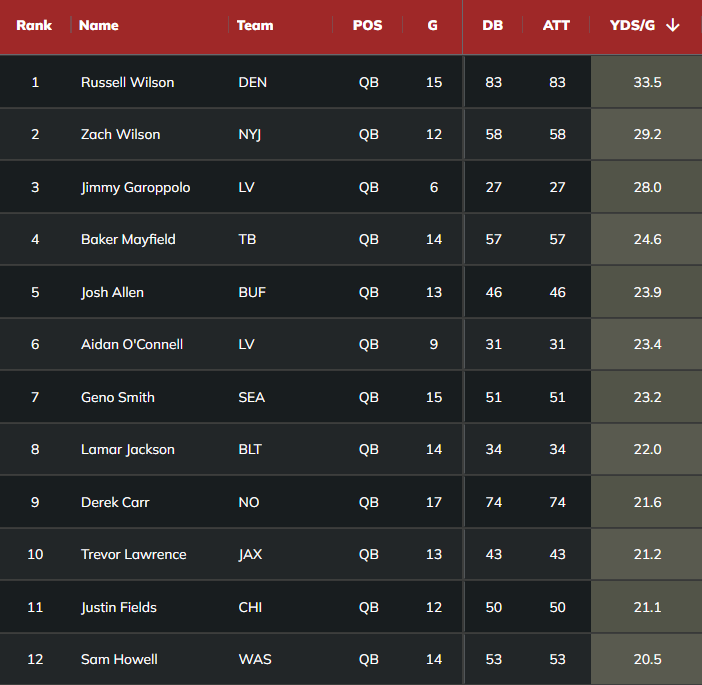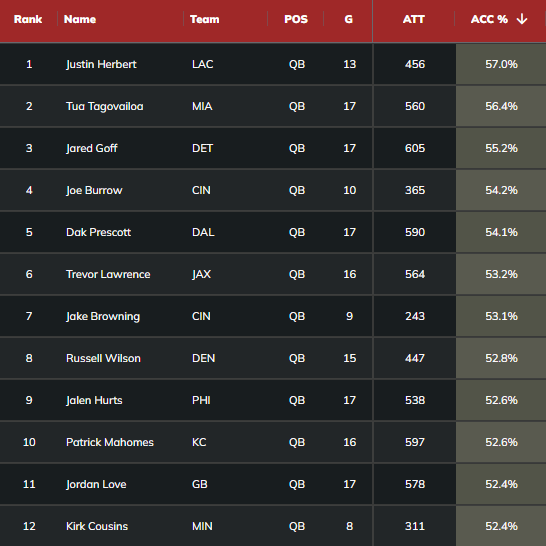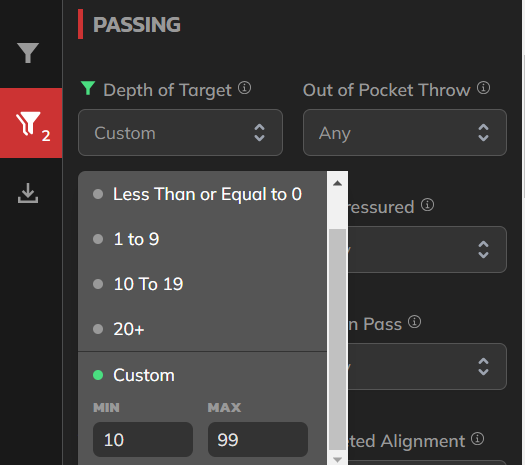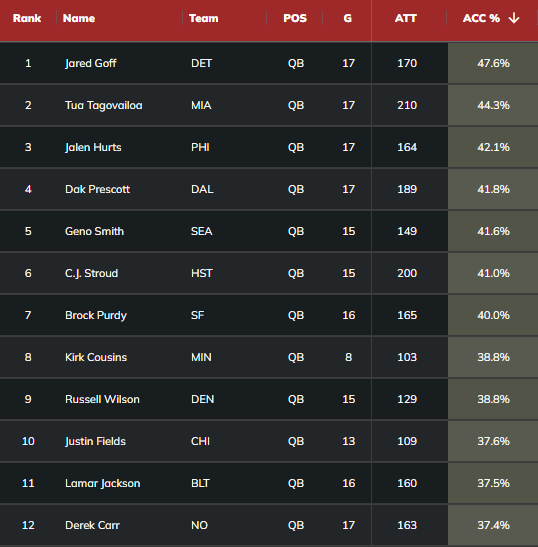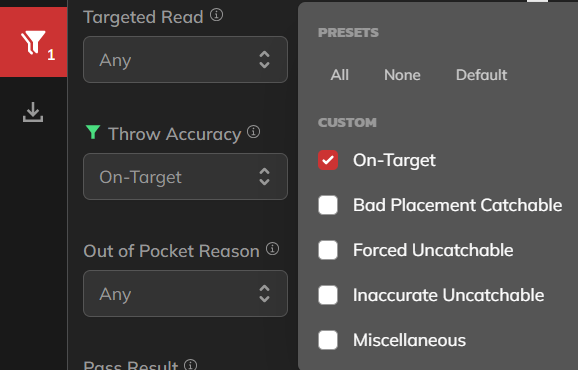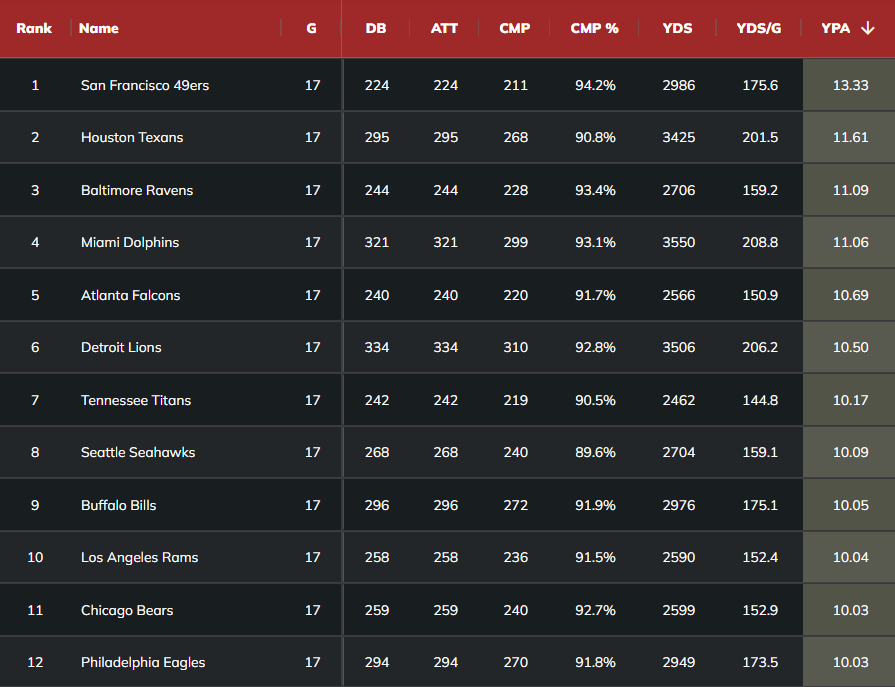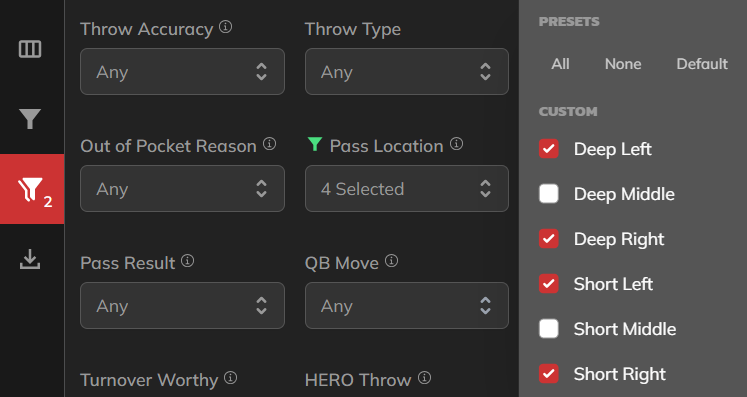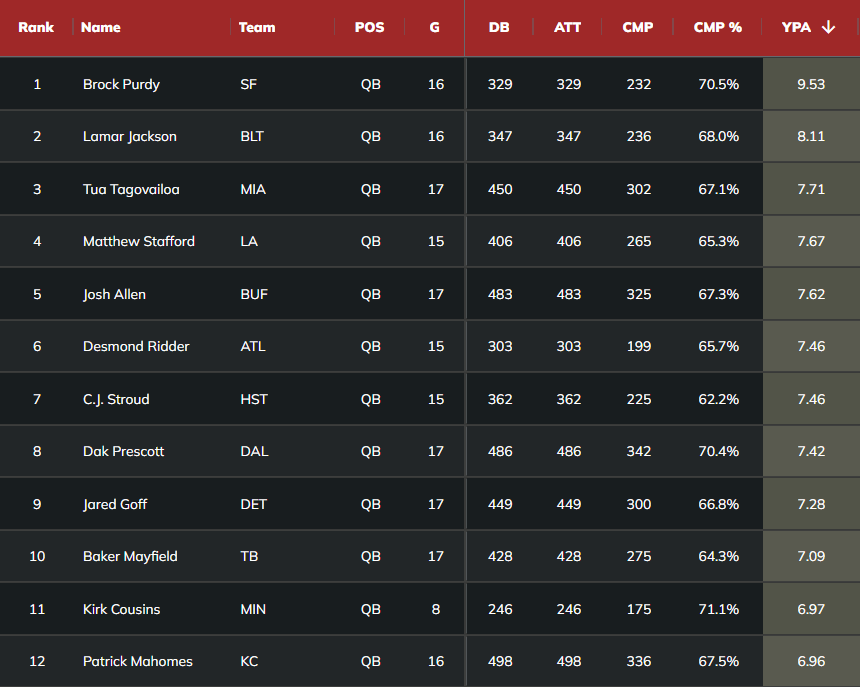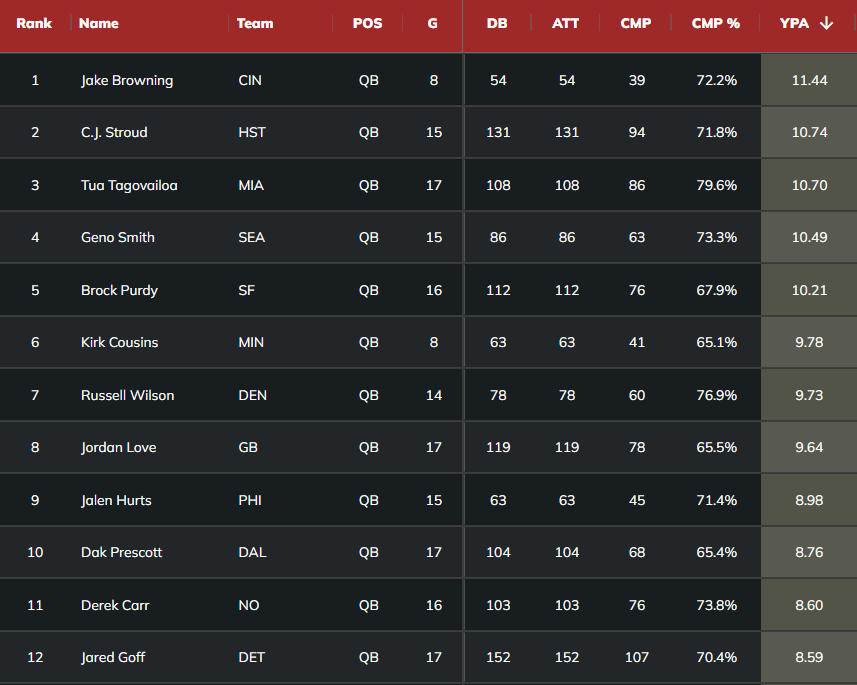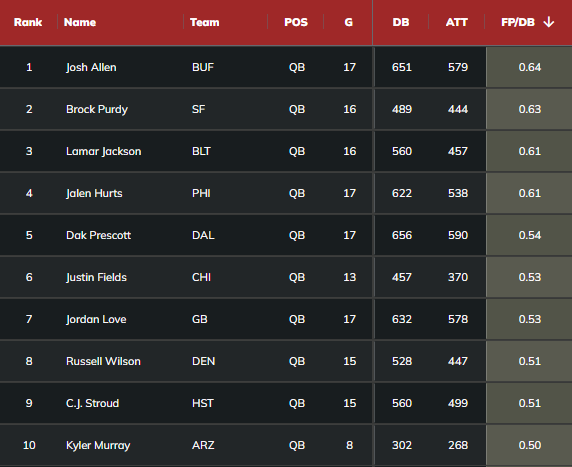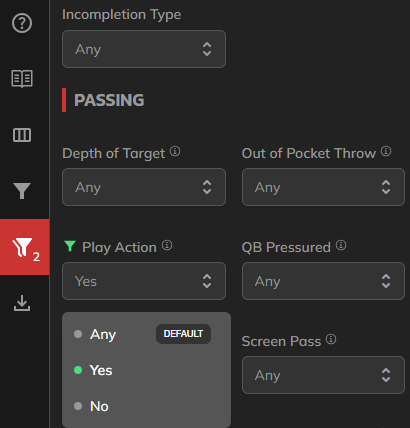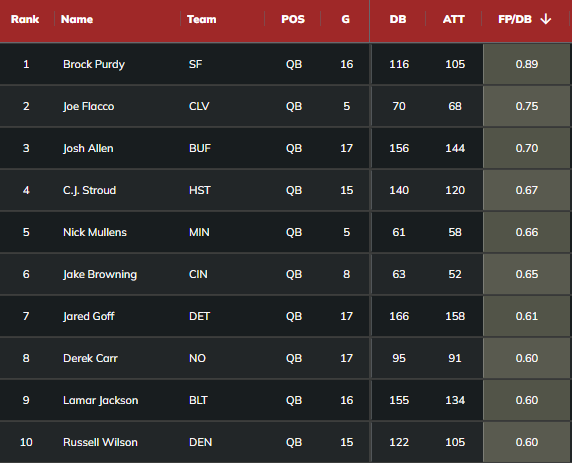I couldn’t fit more than a small fraction of the incredibly cool and powerful stats the Fantasy Points Data Suite has to offer in my original tutorial. That’s what this article is for — to catalog all of the interesting and useful stats I’ve compiled and, by extension, to demonstrate exactly how intelligent, ball-knowing, and handsome the Data Suite can make you look.
If you’d like more detailed instructions on navigating the Data Suite to produce all of these pulls yourself, I’d recommend checking out the Fantasy Points Data 101 article. Here, I’ll just provide the settings I used for each result while doing significantly less step-by-step explanation. This will allow us to explore the NFL’s passing tendencies in a much deeper and more interesting fashion.
Today, we’ll focus on the Advanced Passing table (accessible via the navigation menu at the top of any Data Suite page under the “Passing” section). The information within has greatly improved my understanding of quarterback play in the NFL, and I imagine you’ll find it illuminating as well.
Pressures and Time to Throw
Qualifier: 300 dropbacks
All you have to do for our first pull is open the Advanced Filters menu on the left-hand sidebar, navigate to the Qualifier tab, and input a custom dropback minimum of 300. We’ll be adjusting this throughout the article, which I’ll note for each section as I’ve done above.
With that done and your changes applied via the green button in the top-right, let’s scroll the table horizontally to the far right end. You should see “Press %” as one of the columns here. Sort by it.
This column ranks QBs by the percentage of dropbacks on which they faced pressure. Russell Wilson, Justin Fields, and Bryce Young all placed top-5. If you’re a Steelers or Panthers fan and feel the need to defend one of your team’s QBs, start by pointing out they were under constant siege. (Apologies to the Bears and Broncos fans for whom this article came too late.)
But what if you’re on the other side of that debate? If you’re truly a Fantasy Points Data Suite understander, you would rightfully point out that QBs who hold the ball too long are pressured the most often. Scroll over a few columns to the left, sort by TTT (average time to throw), and we’ve got ourselves a killer counter-argument.
It turns out Fields, Wilson, and Young had among the longest average times to throw in the NFL. Rather than placing it all at the feet of their offensive lines, at least some of the blame for all the pressure these players faced should be assigned to them for failing to read the field and deliver the ball on time.
If your team’s QB seems to constantly be under pressure, it’s probably because he holds the ball too long
— Ryan Heath (@RyanJ_Heath) February 2, 2024
- Justin Fields and Russell Wilson the biggest offenders
- Love saw little pressure despite an average time to throw
- Quick releases for Tua really worked, for a while pic.twitter.com/lqvAPsJcCB
Checkdowns
Let’s scroll back over to the far right of the table and locate the CHK % column (Checkdown Throw Percentage). We could pile further onto Steelers and Panthers fans, but let’s instead click the column twice to sort by ascending — displaying the QBs who checked down the least in 2023.
That’s right, Tua Tagovailoa and Brock Purdy haters — be careful whom you call a “checkdown merchant,” or a Fantasy Points subscriber might put you in your place. These two checked down at the lowest rates of any QB in 2023.
If anybody ever calls Brock Purdy a "screen merchant," a "check-down merchant," or any other type of merchant, link them this.
— Ryan Heath (@RyanJ_Heath) April 9, 2024
Or better yet, tell them to subscribe to @FantasyPtsData.
Purdy checked down and threw screen passes at among the lowest rates in the NFL in 2023. pic.twitter.com/uYlE0WVgJJ
Still, a lower frequency of checkdowns does not necessarily equate to less reliance on checkdowns. We can dig deeper and learn which QBs compiled the most production on these throws.
Qualifier: 25 dropbacks
Play Filter: Targeted Read = Checkdown
Let’s reduce our minimum dropbacks in the Qualifier tab to 25. Then, in the Play tab under the Passing section, select “checkdown” in the Targeted Read filter. This filters the entire table to include only checkdowns, as opposed to having only the single column to work with.
Finally, make sure to apply your changes and sort by YDS/G (passing yards per game).
Aside from a few exceptions like Josh Allen and Lamar Jackson, we can see that the YPG-from-checkdowns leaderboard is mostly populated by the QBs who check down the most (from above). Purdy and Tagovailoa ranked just 23rd and 24th, respectively. But the biggest takeaway is that QBs do not get much overall production from checking down. In general, checkdown discourse is overblown.
But luckily for us, the Data Suite has several other ways to evaluate QBs independent of actual production…
Accuracy
Qualifier: 250 dropbacks
Our team of charters records the accuracy of every throw — 49.5% of all throws were deemed “on-target” last season. After clicking the “Reset” button in the top-right and adjusting our dropback minimum to 250, the easiest way to check this out is simply sorting by the ACC% column.
While the most-accurate QBs of 2023 are below (and made up largely of stars), the least-accurate QBs were headlined by Gardner Minshew, Kenny Pickett, and Zach Wilson. Unsurprisingly, none of that trio is expected to start in 2024.
We can go a step further by adjusting for target depth to see which QBs are the most accurate deeper downfield. In the passing section of the Play tab, set a custom Depth of Target filter between 10 and 99 yards.
Qualifier: 100 dropbacks
Play Filter: Depth of Target = 10 to 99
Once we update the table with the Apply button, Jalen Hurts and C.J. Stroud start to shine. On the other hand, Justin Herbert falls all the way from a 57.0% accuracy rate (1st) to a 35.9% accuracy rate (17th) after filtering for throws 10 or more yards downfield.
Did short screens and checkdowns to Austin Ekeler pad out Herbert’s overall accuracy stat? It doesn’t appear so. When removing the target depth filter but specifically taking out screens, designed targets, and checkdowns (via the Screen Pass and Targeted Read filters), Herbert’s accuracy rate stood at 54.5% (4th-best). He performed similarly in 2022 (55.2%, 4th-best) and 2021 (51.1%, 8th-best) as well. Herbert is simply an excellent short-area passer in general, though he lacks the same edge deeper down the field.
Filtering only for plays where an accurate throw happened also allows us to evaluate offenses somewhat independently of the QB’s ability to place the ball correctly. Let’s briefly move over to the Team Offense view via the gray buttons in the top-right above the table. Once there, select “On-Target” within the Throw Accuracy filter.
Play Filter: Throw Accuracy = On-Target
After applying the change and sorting by YPA (Passing Yards per Attempt), what you'll find may surprise you. It appears Arthur Smith could have engineered an incredibly potent passing attack in 2023 if not for Desmond Ridder’s incompetence.
These were the most efficient passing offenses in the NFL last year, only including plays where the QB threw an accurate ball. Success in this metric seems attributable to some combination of receiver talent and effective scheme. In other words, any poor overall offenses that scored highly here could theoretically be greatly improved by better QB play.
The Falcons had a top-5 passing attack when the throw was on target last year!
— Ryan Heath (@RyanJ_Heath) April 15, 2024
X-Axis: How often the team's throws were on-target
Y-Axis: Yards per Attempt for on-target throws only
Another bullish signal for Drake London and Kyle Pitts?
via @FantasyPtsData pic.twitter.com/ojrehWW2mt
Middle of Field vs. Outside
Yet another cool feature I want to highlight is the ability to differentiate between throws to the middle of the field and to the sidelines. This gives us insight into how each individual quarterback succeeds and fails.
Qualifier: 200 dropbacks
Play Filter: Pass Location = Deep Left, Deep Right, Short Left, Short Right
As you’re likely used to by now, we’ll set the dropback minimum to 200 and filter in the Play tab for pass location, as I’ve done below.
Apply the changes, and observe that Yards per Attempt when targeting the perimeter of the field tracks somewhat closely with overall YPA. That’s mostly because 80.2% of all throws in 2023 went to the outside.
Reverse the filters to select throws only to the middle of the field, and you’ll notice things change significantly.
Qualifier: 50 dropbacks
Play Filter: Pass Location = Deep Middle, Short Middle
Aside from a small Jake Browning sample, Shanahan-tree offenses make up the next five spots on the middle-of-field YPA leaderboard. Matthew Stafford, Lamar Jackson, and Josh Allen stick out as having comparative advantages throwing to the outside. I’ve charted the two views together below for ease of viewing.
Breaking out passing Yards per Attempt:
— Ryan Heath (@RyanJ_Heath) April 16, 2024
Middle of the field (vertical axis)
vs.
Outside (horizontal axis)
A lot of the Shanahan-style systems seem to excel at opening up the middle.@FantasyPtsData pic.twitter.com/PI4ERYguYz
Fantasy Points per Dropback (Best Fantasy Stat)
I’ll end by showing you my favorite QB stat. Reset all your filters and bump the qualifier back up to 300 dropbacks.
Qualifier: 300 dropbacks
Apply the changes, scroll your table all the way to the right, and sort by FP/DB (Fantasy points per dropback).
This is the most predictive QB stat for fantasy football, which I wrote about at length here. Draft whichever of these (non-Steelers) QBs is available at the cheapest cost, and you’ll likely be in good shape for 2024. Read the full article to learn about my super-secret FP/DB sleeper who didn’t hit the dropback minimum.
Just for fun, let’s see how this changes if we filter for only play-action passes. Adjust your qualifier to 50 dropbacks, and select “Yes” in the Play Action filter.
Qualifier: 50 dropbacks
Play Filter: Play Action = Yes
You’ll end up with this beauty. We’ve got the FP/DB GOAT Brock Purdy and elite fantasy QB Joe Flacco topping the chart (that’s not a joke — Flacco has averaged 43.1 pass attempts over ten regular-season starts since 2021, more than 4 attempts per game above what 2023 leader Kirk Cousins averaged). What more could you want?
As with many of the stats in this article, another angle from which to consider this top-10 is in terms of play-callers. I’m seeing a lot of the Shanahan coaching tree, while Kevin Stefanski, Ben Johnson, and even Sean Payton also stick out here as offensive minds who succeed at maximizing their QB talent via play-action.
If this preview has inspired you to dive into the Data Suite yourself, be sure to check out our Discord server — where you can tag me and any other Fantasy Points contributor directly — to answer any questions you may have along your Data Suite journey. When you find something cool, tag @FantasyPtsData on X/Twitter to tell us about it!


